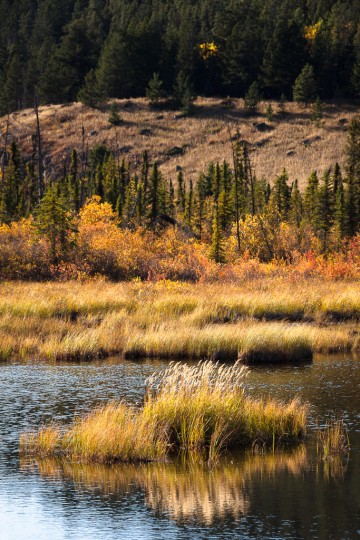 Marsh grass in mountain lake It has been a long time since I’ve posted much here—my apologies—but it should get better again shortly…
I have decided to try “The Online Photographer” Mike Johnston’s “Specific, Detailed Program for Absolutely, Positively Getting Better as a Digital Printmaker”. In short, this is an exercise to get in the habit of working on my photography daily, for a few minutes at least, and to start practicing making prints of my work. I tend to make a few prints occasionally if I’m really excited about a new batch of photos, and a stack of prints for craft sales, etc. The emphasis of the SDPFAPGBAADP program (nice acronym…) is to just practice processing and making prints in a low pressure kind of way.
I’ll give it a try for a while, hopefully I can find the time most days and really get in the habit. If I have a little extra time, I’ll post the day’s photo here too—it should be an interesting mix of images, and I hope you’ll enjoy seeing them. I just printed the photo above, which I took on a trip to Jasper National Park with the family last fall. I have rarely experienced a more pleasant and photogenic evening than this—the fall colours were in their prime, the temperature cool but the breeze warm, and the family was patient… perfect.
And, as always, I appreciate your feedback—please feel free to leave me a comment with your comments or critiques!
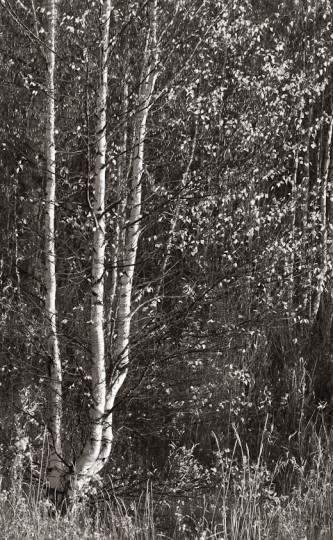 Three autumn birch It’s been a long time since I’ve posted a new photo, and to be honest, it’s been a while since I’ve made any new images. I have been working on re-processing some images into black and white, including this one here.
I love a great B&W photograph, and after listening to this podcast by LensWork editor, Brooks Jensen, I’ve been inspired to figure out for myself what it takes to make a great B&W image, rather than a pretty-good image. And, thanks to the flexibility afforded by capturing and processing digitally, I’ve been going through my image catalogue and giving it a try.
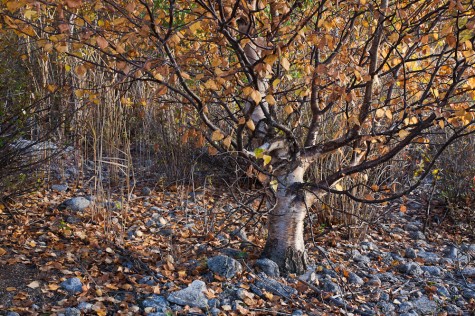 Paper Birch along rocky Ministik shoreline It is unusual to find exposed rock along the shores of the lakes in this part of Alberta, but this beautiful shoreline along Oliver Lake in the Ministik Game Bird Sanctuary just east of Edmonton had several hundred meters of this gorgeous blue-grey stone typical of the Beaver Hills/Cooking Lake moraine landform. Tall reeds and grasses, all dried up by this time, grew from between the stones and above the high water mark there were aspen, birch, and spruce. And then there was this tree—growing near the water in a little clearing.
My timing was just right—all the tree’s leaves had turned to this reddish yellow, with a few fallen to the ground to contrast the colour of the rocks (the next few days were quite windy, stripping most of these leaves for the season). When I first arrived at this spot, the sun was reasonably low in the sky, but the white bark of the birch tree was still reflecting too much light and the contrast was more than my camera could capture. Sometimes, bracketing exposures and combining them to an HDR image for processing can reign in such high-contrast scenes, but in this case a slight breeze was rustling the leaves and grass stems, which makes it very difficult to blend multiple exposures successfully.
Looking to the west however, I noticed that a bank of high stratus clouds rose a few degrees above the horizon in the otherwise perfectly clear sky. Normally, this is bad news if you’re trying to photograph dramatic late-day sidelighting and sunset colours (which I was trying to do). In this case though, I waited until the sun had just dipped behind the thin leading edge of the clouds, causing the light to dim a little and to diffuse ever so slightly—reducing the contrast in the scene, but still lighting the brilliant fall colours. I hurried to capture a few compositions that I’d determined while waiting for the light, and far too quickly—the light was gone. I walked back to the truck as the lacklustre sky simply grew darker with the sun hidden behind the advancing clouds—but I couldn’t possibly have been any happier.
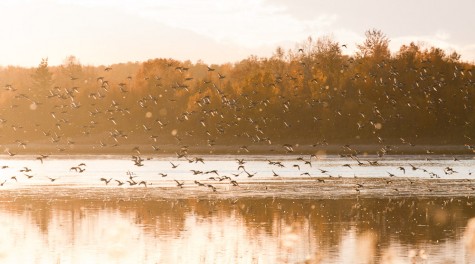 Waterfowl rising from Ministik Lake Here’s another photograph I made last week, along Oliver Lake out at the Ministik Lake Gamebird Sanctuary. As the sun was setting, hundreds (if not thousands) of ducks were settling on the lake, rising in large flocks if unnamed photographers (or their dog) moved too quickly. I normally try hard when processing a photograph to make sure that there is detail in both the highlights and shadow. In this case however, I found that pushing the brightness up really did a better job of capturing the mood of looking west across the lake into the sun, watching the birds against the brilliant, backlit fall colours. They say the rules are there to be broken, right?
 Golden autumn aspen shoreline If you’re in the Edmonton area, and haven’t been out enjoying (and photographing) the fall colours this week, I have one word for you—go! I’ll let this photograph speak the thousand words’ encouragement.
I’ve been exploring the south-west corner of Ministik Lake Sanctuary, following game trails along the shore of Oliver Lake and coming across views like this one. This is one of my favourite autumn combinations—yellow aspen & birch, bright dried grasses, all against a blue sky reflected in a still lake, and with just a few dark spruce thrown in for accent. Gorgeous.
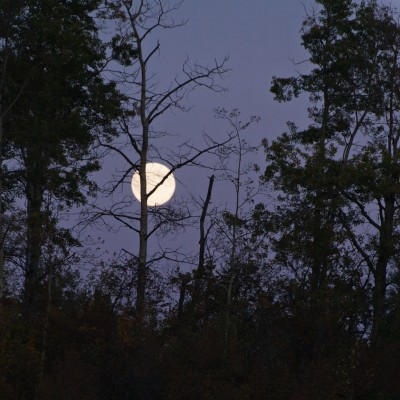 Harvest moon rising behind aspen I went out to the Ministik Lake this evening with the family (& my camera, of course) to celebrate the autumnal equinox, and to witness the “Super Harvest Moon” that occurred tonight for the first time in 20 years (click here for more info on that). For those of you who missed it—(it wasn’t much different than any other nice full moon-rise)—I thought I’d quick post this photograph that I made of the moon tonight. It was a lovely evening—geese & ducks whistling by overhead, a few quiet birdsongs (White-throated- & Lincoln’s Sparrows), beavers on the lake, and coyotes & bats as the moon came up. Welcome autumn.
 Autumn foliage triptych Here are three photographs of autumn colour in the plants out at Ministik Lake. While processing these images, I played around with de-saturating all the colours except for those of the main subject. This kind of manipulation of the image is outside of the regular “darkroom-style” processing that I usually restrict myself to—but in this case, I really like how it looks. I also added a fairly heavy vignetting effect (the darkening of the corners) to further accentuate the main subject of each image.
With their similarities in colour, subject matter, and processing technique, I found that these three photographs complemented each other when viewed side-by-side. I don’t know the “theory” behind why some images work together as a group, but I do know that sometimes a triptych is definitely greater than the sum of its parts. (Click here to see a couple more of my favourite triptychs). As always, I’d love to hear your thoughts—just leave a comment below.




Click these thumbnails to see a larger vesion of each image individually (use your arrow keys to move between them).
|
(Click photos to enlarge)
|











